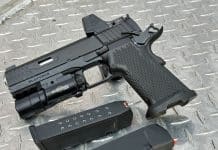Machine Gun Monday Presents the MG42.
The Maschinengewehr 42 (Machine Gun 42) was designed and built by the Germans and used during the second half of World War 2. The MG42 is well-known for it’s high rate of suppressive fire.
One of the weapon’s most notable features was its exceptionally high rate of fire of about 1,200 rounds per minute, twice the rate of the Vickers and Browning machine guns at 600 round per minute. So effective was the weapon in laying suppressive fire that the United States Army created training films to aid its soldiers in dealing with the psychological trauma of facing the weapon in battle. At such a high rate the human ear cannot easily discern the sound of individual bullets being fired, instead hearing a sound described as like "ripping cloth" or a buzzsaw, giving rise to the nickname "Hitler’s buzzsaw" (and the German soldiers’ Hitlersäge ("Hitler’s saw") or "bonesaw").
The MG 42’s high rate of fire resulted from analysis which concluded that since a soldier only has a short period of time to shoot at an enemy, it was imperative to fire the highest number of bullets possible to increase the likelihood of a hit. The disadvantage was that the weapon consumed exorbitant amounts of ammunition and quickly overheated its barrel, making sustained fire problematic. Thus, while individual bursts left the weapon as highly concentrated fire at 1,200 rounds per minute, the Handbook of the German Army (1940) forbade the firing of more than 250 rounds in a single burst and indicated a sustained rate of no more than 300–350 rounds per minute to minimize barrel wear and overheating.
The MG42 often used a large fire team.
The optimum operating crew of an MG 42 for sustained fire operation was six men: the gun commander, the No.1 who carried and fired the gun, the No.2 who carried the tripod, and Nos. 3, 4, and 5 who carried ammunition, spare barrels, entrenching tools, and other items. For additional protection the commander, No.1 and No.2 were armed with pistols, while the remaining three carried rifles. This large team was often reduced to just three: the gunner, the loader (also barrel carrier), and the spotter.
The German and Allied doctrines differed with machine gun use.
The U.S. doctrine of the era centered around the rifleman, with the machine gun serving a support role. German doctrine was the reverse, with the machine gun placed in a central role and rifleman employed in support. This meant that German forces deployed far more machine guns per equivalent-sized unit than the allies, and that Allied troops assaulting a German position almost invariably faced the firepower of the MG42. It was possible for operating crews to lay down a non-stop barrage of fire, ceasing only when the barrel had to be replaced. This allowed the MG 42 to tie up significantly larger numbers of enemy troops. Both the Americans and the British trained their troops to take cover from the fire of an MG 42, and assault the position during the small window of barrel replacement. The high rate of fire of the MG 42 sometimes proved a liability, mainly in that, while the weapon could be used to devastating effect, it could quickly exhaust its ammunition supply. For this reason, it was not uncommon for all soldiers operating near an MG 42 to carry extra ammunition, thus providing the MG 42 with a backup source when its main supply was exhausted.
Specifications

* The views and opinions expressed on this web site are solely those of the original authors and contributors. These views and opinions do not necessarily represent those of Guns & Tactics Magazine,
the administrative staff, and/or any/all contributors to this site.












